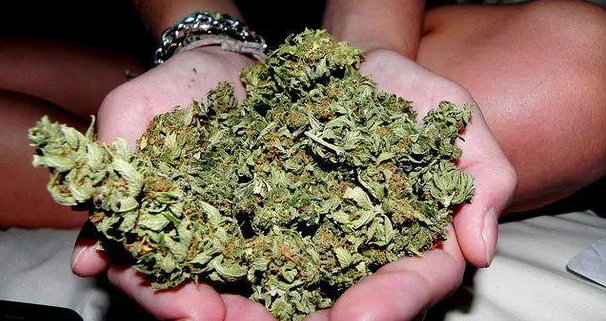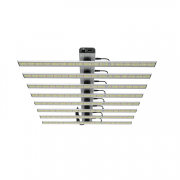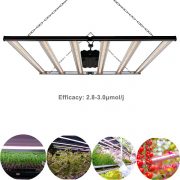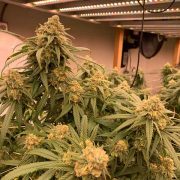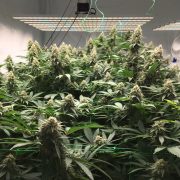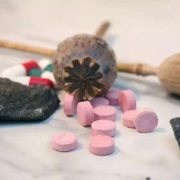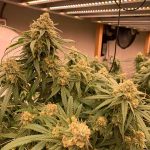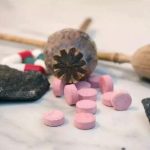How to Grow Cannabis(Marijuana)?
Easiest 10 Step Guide – How to Grow Cannabis(Marijuana)?
What Is Cannabis(Marijuana)?
Cannabis (/ˈkænəbɪs/) is a genus of flowering plants in the family Cannabaceae. The number of species within the genus is disputed. Three species may be recognized: Cannabis sativa, Cannabis indica, and Cannabis ruderalis; C. ruderalis may be included within C. sativa; all three may be treated as subspecies of a single species, C. sativa; or C. sativa may be accepted as a single undivided species. The genus is widely accepted as being indigenous to and originating from Central Asia, with some researchers also including upper South Asia in its origin.
The plant is also known as hemp, although this term is often used to refer only to varieties of Cannabis cultivated for non-drug use. Cannabis has long been used for hemp fiber, hemp seeds, and their oils, hemp leaves for use as vegetables and as juice, medicinal purposes, and as a recreational drug. Industrial hemp products are made from cannabis plants selected to produce an abundance of fiber. To satisfy the UN Narcotics Convention, some cannabis strains have been bred to produce minimal levels of tetrahydrocannabinol (THC), the principal psychoactive constituent. Some strains have been selectively bred to produce a maximum of THC (a cannabinoid), the strength of which is enhanced by curing the fruits. Various compounds, including hashish and hash oil, are extracted from the plant.
In the US, “industrial hemp” is classified by the federal government as cannabis containing no more than 0.3% THC by dry weight. This classification was established in the 2018 Farm Bill and was refined to include hemp-sourced extracts, cannabinoids, and derivatives in the definition of hemp.
Globally, in 2013, 60,400 kilograms of cannabis were produced legally. In 2014 there were an estimated 182.5 million cannabis users (3.8% of the population aged 15–64). This percentage did not change significantly between 1998 and 2014.
Cannabis is an annual, dioecious, flowering herb. The leaves are palmately compound or digitate, with serrate leaflets. The first pair of leaves usually have a single leaflet, the number gradually increasing up to a maximum of about thirteen leaflets per leaf (usually seven or nine), depending on variety and growing conditions. At the top of a flowering plant, this number again diminishes to a single leaflet per leaf. The lower leaf pairs usually occur in an opposite leaf arrangement and the upper leaf pairs in an alternate arrangement on the main stem of a mature plant.
The leaves have a peculiar and diagnostic venation pattern that enables persons poorly familiar with the plant to distinguish a cannabis leaf from unrelated species that have confusingly similar leaves. As is common in serrated leaves, each serration has a central vein extending to its tip. However, the serration vein originates from the lower down the central vein of the leaflet, typically opposite to the position of, not the first notch down, but the next notch. This means that on its way from the midrib of the leaflet to the point of the serration, the vein serving the tip of the serration passes close by the intervening notch. Sometimes the vein will actually pass tangent to the notch, but often it will pass by at a small distance, and when that happens a spur vein (occasionally a pair of such spur veins) branches off and joins the leaf margin at the deepest point of the notch. This venation pattern varies slightly among varieties, but in general, it enables one to tell Cannabis leaves from superficially similar leaves without difficulty and without special equipment. Tiny samples of Cannabis plants also can be identified with precision by microscopic examination of leaf cells and similar features, but that requires special expertise and equipment.

Is Cannabis(Marijuana) Addictive?
Marijuana use can lead to the development of problem use, known as a marijuana use disorder, which takes the form of addiction in severe cases. Recent data suggest that 30% of those who use marijuana may have some degree of marijuana use disorder.18 People who begin using marijuana before the age of 18 are four to seven times more likely to develop a marijuana use disorder than adults.
Marijuana use disorders are often associated with dependence—in which a person feels withdrawal symptoms when not taking the drug. People who use marijuana frequently often report irritability, mood and sleep difficulties, decreased appetite, cravings, restlessness, and/or various forms of physical discomfort that peak within the first week after quitting and last up to 2 weeks. Marijuana dependence occurs when the brain adapts to large amounts of the drug by reducing the production of and sensitivity to its own endocannabinoid neurotransmitters.
Marijuana use disorder becomes an addiction when the person cannot stop using the drug even though it interferes with many aspects of his or her life. Estimates of the number of people addicted to marijuana are controversial, in part because epidemiological studies of substance use often use dependence as a proxy for addiction even though it is possible to be dependent without being addicted. Those studies suggest that 9% of people who use marijuana will become dependent on it rising to about 17% in those who start using in their teens.
In 2015, about 4.0 million people in the United States met the diagnostic criteria for a marijuana use disorder;3 138,000 voluntarily sought treatment for their marijuana use.
THC, the principal psychoactive constituent of the cannabis plant, has low toxicity. The dose of THC needed to kill 50% of tested rodents is extremely high. Cannabis has not been reported to cause fatal overdose in humans.

How Long Does Cannabis(Marijuana) Stay in Your System?
Tetrahydrocannabinol, the chemical in marijuana that makes people feel “high,” can stay in the body for several days or even weeks.
The length of time this chemical stays in the body or continues to show in a drug test depends on many factors. These include:
how much body fat a person has
how often they consume the drug
how much someone smokes
the sensitivity of the drug test
Drugs such as alcohol may completely disappear from the body in just a few hours. In comparison, weed lingers much longer.
Drug tests can detect tetrahydrocannabinol, or THC, in urine, blood, and hair for many days after use, while saliva tests can only detect THC for a few hours. This is because of the way the body metabolizes THC.
THC is a lipid-soluble chemical. This means that it binds to fat in the body, which increases the length of time it takes for someone to eliminate THC completely.
Research on the amount of time a test can detect marijuana shows a wide range of averages. Research from 2017 estimates a detection window for a single marijuana cigarette of about 3 days.
The same study emphasizes that detection windows vary and depend on how often a person smokes.
It showed:
For someone smoking marijuana for the first time, tests may detect it for about 3 days.
In someone who smokes marijuana three or four times per week, the detection window is 5–7 days.
For people who smoke marijuana once a day or more, tests may detect it in their system for 30 days or longer.
Detection windows also depend on the kind of test a person undertakes. General estimates for various marijuana tests are as follows:
Urine tests can detect marijuana in the urine for approximately 3–30 days after use.
Saliva tests can detect marijuana for approximately 24 hours after use. Some saliva tests have detected marijuana for up to 72 hours.
Hair tests are the most sensitive tests, detecting THC for up to 90 days after use. However, these tests are testing the oil in skin that transfers to hair, and so they may occasionally show a false positive. A person who comes into contact with a THC user could, theoretically, test positive on a hair test.
Blood tests can only detect THC for 3–4 hours.

Where Is Cannabis(Marijuana) Legal?
https://en.wikipedia.org/wiki/Legality_of_cannabis_by_U.S._jurisdiction
https://en.wikipedia.org/wiki/Legality_of_cannabis

How to Grow Cannabis(Marijuana) Indoor Quickly?
Step 1: Find a Place to Grow
Growing indoors is much more private than growing outdoors and you also get more control over your growth.
Indoor cannabis grow can be surprisingly cheap to get started and maintain, especially if you plan on growing just a few plants.
You have more control over everything in an indoor growing environment, which means that indoor growers can consistently produce dank buds. However, this dank weed-growing power comes with more responsibility. As an indoor grower, your plants are 100% reliant on you your care if they are to survive. If you don’t provide everything your plants need, they will die.
What space works best?
You can grow cannabis almost anywhere that has easy access to water and fresh air…
a spare room
a closet
garage
grow tent
extra bathroom
even the inside of a computer case!
I recommend a Space Bucket instead when thinking about where to grow indoors, you should also consider the temperature (also referred to as ‘temps’) of your grow space and remember your temps will rise once you have your grow lights running!.
A thermometer – Temperature is important when growing cannabis indoors. Young growing cannabis plants grow fastest when temps a bit warmer, in the 70-85°F (20-30°C) range.
When plants are a bit older, in the budding/flowering stage, it’s best to keep temps slightly cooler, around 65-80°F (18-26°C) to produce buds with the best color, trichome production, and smell.
Because temps are so important, it’s best to be able to have some amount of control over the temperature of your grow area. When growing indoors, your grow lights will give off heat. Generally, the more powerful your lights, the more heat they give off.
If you want to install a lot of bright lights in a small space, you will likely have to install an air conditioner in addition to your exhaust system to make sure you keep your temps in the right range.
If you’re growing just a few plants in a grow tent or box, usually you can install a fan to pull hot air away from the hot lights and out a window to keep things cool enough.
Some lights tend to cause more heat than others, and we’ll help you find the right lights for your space in Step 2.

Step 2: Choose Your Light
LEDs are much more powerful than CFLs or any other fluorescent lighting. They are top-tier grow lights on par with HID lighting (HPS, LEC) when it comes to how much bud they can produce. They’re visually attractive and tend to be more appealing to growers because they’re not as ‘old-fashioned’ (though they tend to cost more). In fact, LEDs are the only grow lights that have seen major technological research and development in the past 10 years.
LED grow lights work great for growing cannabis and some companies have been refining their models for years (the combination of parts is almost like a company’s recipe). Each LED model is different and needs to be kept a different distance away from your plants. It can sometimes be hard to find any “standard” advice about growing with LEDs, yet these days there are quite a few brands that are well-tested and trusted by cannabis growers and these brands tend to have good support for questions. When in doubt, it’s always a good idea to just ask the manufacturer about how far away the lights should be kept, as that’s where new growers are most likely to mess up.
Step 3: Choose Your Growing Medium
Each growing medium that you can use has different care and watering requirements.
These are the most common grow mediums:
Soil – grow in organic composted super soil for the easiest growing experience, or start with the popular Fox Farms Ocean Forest soil mix (FFOF already contains enough nutrients to last the first month of your young plant’s life).
Soilless Mix – anything besides soil including coco coir, perlite, vermiculite, etc. (all soilless mixes are technically considered hydroponic growing since there’s no soil).
Directly in Water / Hydroponics – Get some of the fastest growing and biggest yields possible, especially when combined with HID/LEC/LED grow lights.
Less Common Types of Hydro – Some people grow with plant roots suspended in misted air (aeroponics) or in a tank with fish (aquaponics), but these are relatively less common for cannabis growers.
What’s the Best Soil? Your absolute best option would be to compost your own soil (or purchase composted soil) which gets incredible taste results but does take a little more work (or money if you buy it).
For those of us who prefer pre-made mixes, I recommend starting with the popular soil since it’s already supplemented with plenty of nutrients that work very well for young cannabis plants. It’s a rich yet still somewhat airy soil that is made for plants just like cannabis and has been used by growers for years.
If you have limited soil options, choose an organic potting mix which is usually available in some form in the gardening section of any big-box store. As long as you use good cannabis nutrients, a regular organic potting mix will work just fine.
Step 4: Get Cannabis-Friendly Nutrients
Soil growers – unless you’re growing with composted super soil, you will need to get cannabis nutrients made for soil to make sure your plants produce at their best. Even if you started with amended soil, you will still need to start adding nutrients once you reach the flowering/budding stage as cannabis plants are heavy feeders and your plants will have already used up most of the nutrients in the soil by the time budding begins.
Soilless & Hydroponic growers – If you are growing in any medium besides soil, like a soilless mix or directly in water, you will want to get cannabis nutrients specifically made for hydroponics.
Step 5: Get Cannabis Plants
For those growers lucky enough to know other cannabis growers in real life, getting plants is usually pretty simple. Many cannabis collectives and dispensaries will happily sell you clones though they tend to be a little less liberal when it comes to selling seeds. A great advantage of purchasing clones or seeds from a trusted source is that you know you can trust the genetics you are receiving.
Yet many people do not know any other growers in real life. For these soon-to-be growers, the best option may be to purchase cannabis seeds online from a breeder or seed bank.
Surprising Fact: No one in the US has ever gone to jail or prison from simply ordering cannabis seeds online from overseas.
If you are considering this for the first time, you may be surprised to learn that, because of the way the laws about customs work in America, it is actually reliable and safe to buy your cannabis seeds online from a reputable seed bank as long as you get it from outside the US (sending seeds from one place to another in the US can get you in big trouble though!).

Step 6: Germinate Your Seeds
If you have already a rooted clone (a live cannabis plant) please skip right to Step 7.
There are many methods for cannabis seed germination.
Personally, I think one of the easiest ways to germinate a cannabis seed is to place it directly in a specialized starter cube like a Rapid Rooter.
Just keep the Rapid Rooters moist (but not soaking) and warm. It can help to put your tray on a seedling heat mat. Seedlings should pop in a few days to a week.
So far Rapid Rooters with a heat mat have given me the best germination rates of any method. They work with any growing medium, too – once the seedling has emerged, you can stick the cube directly into your growing medium or hydroponic system.
Another popular way to germinate seeds is via the paper towel method.
Paper Towel Method:
You will need…
Cannabis seeds
2 plates
Paper towels
Water
A place to plant sprouted seeds
NOTE: If seedlings seem to be “stretching” upwards or growing very tall, usually it’s because they want more light.
Step 7: Vegetative Stage – Only Stems and Leaves
Once your plant grows the first “regular” set of leaves, it’s pretty much officially in the vegetative stage. How long is the vegetative stage?
Cannabis plants keep getting bigger and bigger with long days (vegetative stage) and start making buds when they get long nights (flowering stage).
Young growing cannabis plants grow fastest when the temperature is a bit warmer than a comfortable room temperature, around 70-85°F (20-30°C). But as long as it doesn’t get freezing cold or burning hot, your plants should be able to grow in a wide range of temperatures.
How often do I water my cannabis plants?
In this stage, your plant will focus ONLY on getting big and strong. Buds and flowers are not part of the plant’s vocabulary yet.
If you’re feeding your plant with additional nutrients, start at half strength as it can be easy to burn your young cannabis plants. Bring to 3/4 strength one plant starts growing vigorously and if your plant displays signs of needing more nutrients even though the pH is in a good range.
Only feed nutrients at full strength if the plant is showing signs that it needs more nutrients (lower leaves are turning lime green, then yellow, then falling off – the first sign of a nitrogen deficiency, the most common type of deficiency – if the plant is not getting enough nutrients).
At this stage, you can’t tell if one of your cannabis plants is going to be a boy or a girl yet.
Light
Give plants 18-24 hours/light a day in the vegetative stage when growing indoors. 18 hours of light a day is preferable, 24 is for the experimental type of grower.
The size your plant gets in this stage will have a huge impact on the final size of your plant.

Step 8: Flowering Stage – Buds Start Growing!
This is the stage where your plants start making buds. This stage will last until harvest!
During this stage, you will need to…
Change to 12-12 Light Schedule
Identify Gender of Cannabis Plants
Get Rid of any Males
We’re getting to the exciting part!
Most strains of cannabis begin this stage once they’re getting at least 12 hours of uninterrupted darkness a night. Autoflowering cannabis plants will start the flowering stage without needing a lighting change.
Light
Indoors, you must change to a 12-12 light schedule, with 12 hours of light & 12 hours of uninterrupted darkness each day (usually accomplished by putting your lights on a timer) to get your cannabis to start flowering (making buds).
The flowering stage is where your plant goes through “puberty” and basically reveals whether they are a boy or a girl.
Unfortunately, for regular seeds, half your plants will end up female and half will end up male. That’s why a lot of growers prefer starting with clones or buying feminized seeds – all the resulting plants will grow into females.
As cannabis growers, we’re only looking for females as female plants are the only ones that make buds. Male plants just make pollen sacs (balls) that cannot be used for smoking.
A week or two after you initiate the 12-12 light schedule, your plants will reveal their gender…
Female plants start growing wispy white hairs at the tops of branch joints. These are the pistils of her flowers/calyxes. You’ll get bunches of these calyxes growing on top of each other to make buds, and each calyx will have a few white hairs coming out of it. This is great news! It means this plant will eventually grow beautiful weed with buds/flowers/ganja that you can smoke.
Male plants start growing balls/pollen sacs with no white hairs/pistils. Unfortunately, most male plants do not develop psychoactive properties like girls do in their flowers. Plus, male plants can pollinate your female plants and cause them to make less bud and more seeds. Therefore, most serious cannabis growers choose to remove and dispose of male plants as soon as they show their sex.
Note: The sturdy green growths are not pistils, they are always there on both boy and girl plants. When looking for gender, you’re specifically looking for white wispy hairs (pistils).
Ok, so you’ve gotten rid of your male plants. Your female plants will be growing more and more white hairs and before you know it, actual buds/flowers/trees are forming. Woohoo!
Now that you’re fully in the flowering stage, it’s best to keep temps slightly cooler, around 65-80°F (18-26°C) to produce buds with the best color, trichome production, and smell.
It’s important to pay close attention to your cannabis plants during the flowering stage. This is because in this stage your plant is much more likely to suffer from nutrient problems as they’re focusing all their energy on growing buds.

Step 9: Harvest Your Cannabis
When to Harvest Weed? Is She Ready for Harvest?
Wait until your buds stop growing new, white hairs. By this point, your buds should be fragrant (the whole grow room or area will likely smell strongly of cannabis), plump, and ‘filled out.
Wait until at least 40% of the white hairs have changed color (darkened) and are curling in. This marks the beginning of the harvest window. Buds harvested now will have more of a speedy effect and are not at full potency.
Harvest when 50-70% of the hairs have darkened for the highest THC levels
Harvest when 80-90% of the hairs have darkened for more a couchlock, anti-anxiety effect (some of the THC has turned into the more relaxing CBN)
The hardest part of growing cannabis for many new growers is waiting for the right time to harvest.
There are additional cannabis harvest methods that are much more precise – such as using trichomes to know when to harvest your buds.
Just get a sturdy pair of scissors and cut the plant down in the most convenient way possible. Seriously…that’s it!
Trimming comes next; it’s one of the most rewarding and physically taxing parts of the entire grow, but it’ll be worth it!

Step 10: Dry & Cure Your Buds Like a Professional
After you have cut off and trimmed all of your glittery, beautiful fat buds, you will want to hang them upside down in a cool, dark place with plenty of ventilation so that they can dry out.
Dry buds slowly for best results and check often for mold or overdrying. You’ve worked way too hard to lose your crop now!
After your cannabis buds have dried (thin stems snap, but the thicker stems are still a bit bendy), it’s time to start curing them so they’re smooth, taste good, smell good, and have the best effects.
To cure your buds, put them in tightly closed quart-sized mason jars in a cool dark place. Fill each jar loosely about 3/4 of the way full.
For the first 2 weeks of curing, open the jars once a day for several seconds to get fresh air in your jars and release any moisture.
If your buds feel moist when you check on them, leave the tops of the jars off until the outsides of the buds feel dry to the touch. Too-moist bud is what causes mold!
Special jars will make curing a lot easier, as they will naturally regulate the humidity in your jars.
After your cannabis has been curing for at least 2 weeks, and it hasn’t felt wet every time you’ve checked the jars for at least a week, you can start opening the lid once a week instead of once a day.
Some people only cure their bud for 1-2 weeks total while others cure their bud for 30 days or more. Because you need to open the jar regularly, you can always sample some as it’s curing to get a feel for whether it’s done or not.
Cannabis tends to be more potent if you cure it for at least a month.
Curing for longer than 6 months doesn’t do anything, and cannabis can become less potent over time as THC turns to CBN. Keep your harvest in a cool, dry, airtight space for long-term storage.
That’s it! 10 Steps and You’ve Got Your Very First Cannabis Harvest!
To buy a Super High-yield Cannabis Plants Grow Light go to
https://eaglestarlighting.com/product-item/led-grow-light/.

